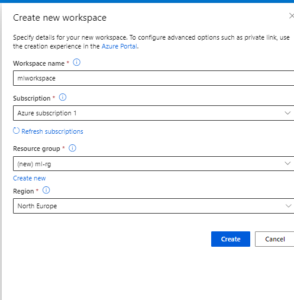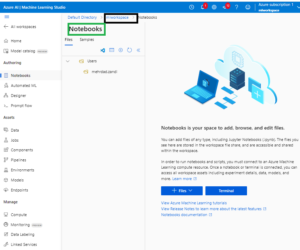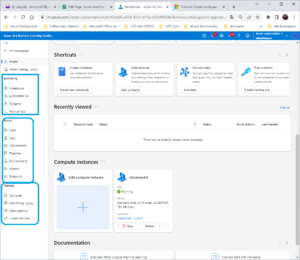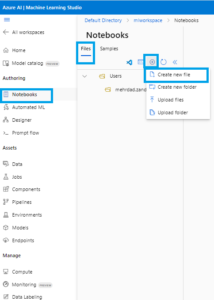Azure Machine Learning workspace
In this post, we will create the resources you need to start working with Azure Machine Learning.
- A workspace. To use Azure Machine Learning, you’ll first need a workspace. The workspace is the central place to view and manage all the artifacts and resources you create.
- A compute instance. A compute instance is a pre-configured cloud-computing resource that you can use to train, automate, manage, and track machine learning models. A compute instance is the quickest way to start using the Azure Machine Learning SDKs and CLIs. You’ll use it to run Jupyter notebooks and Python scripts in the rest of the tutorials.
Prerequisites
An Azure account with an active subscription. If you haven’t create a free account Here.
Create the workspace
The workspace is the top-level resource for your machine learning activities, providing a centralized place to view and manage the artifacts you create when you use Azure Machine Learning.
If you already have a workspace, skip this section and continue to Create a compute instance.
If you don’t yet have a workspace, create one now:
- Sign in to Azure Machine Learning studio
- You will see Welcome to the Azure Machine Learning Studio, then Select Create workspace
- Provide the following information to configure your new workspace
As shown in the following figure:
Press to Create button and wait until mlworksapce is created.
Create a compute instance
You’ll use the compute instance to run Jupyter notebooks and Python scripts in the rest of the coming posts . If you don’t yet have a compute instance, create one now:
- On the left navigation, select Notebooks.
- Select Create compute in the middle of the page. As seen in the following figure:
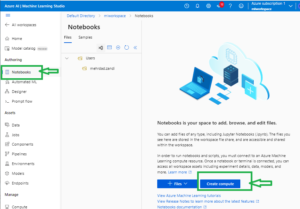
- Supply a name. Keep all the defaults on the first page.
- Keep the default values for the rest of the page.
- Select Review + Create and then press to Create button
Now you have a worksapce (mlworkspace) and a Notebooks with a Compute (mlcompute) as seen in the following image (you can’ see mlcompute):
Description of the studio
The studio is your web portal for Azure Machine Learning. This portal combines no-code and code-first experiences for an inclusive data science platform.
Review the parts of the studio on the left-hand navigation bar:
- The Authoring section of the studio contains multiple ways to get started in creating machine learning models. You can:
- Notebooks section allows you to create Jupyter Notebooks, copy sample notebooks, and run notebooks and Python scripts.
- Automated ML steps you through creating a machine learning model without writing code.
- Designer gives you a drag-and-drop way to build models using prebuilt components.
- The Assets section of the studio helps you keep track of the assets you create as you run your jobs. If you have a new workspace, there’s nothing in any of these sections yet.
- The Manage section of the studio lets you create and manage compute and external services you link to your workspace. It’s also where you can create and manage a Data labeling project.
Learn from sample notebooks
Use the sample notebooks available in studio to help you learn about how to train and deploy models. They’re referenced in many of the other articles and tutorials.
- On the left navigation, select Notebooks.
- At the top, select Samples.
- Use notebooks in the SDK v2 folder for examples that show the current version of the SDK, v2.
- These notebooks are read-only, and are updated periodically.
- When you open a notebook, select the Clone this notebook button at the top to add your copy of the notebook and any associated files into your own files. A new folder with the notebook is created for you in the Files section.
Create a new notebook
When you clone a notebook from Samples, a copy is added to your files and you can start running or modifying it. Many of the tutorials will mirror these sample notebooks.
But you could also create a new, empty notebook, then copy/paste code from a tutorial into the notebook. To do so:
- Still in the Notebooks section, select Files to go back to your files,
- Select + to add files.
- Select Create new file.
Clean up resources
If you plan to continue now to other tutorials, skip to Next steps.
Stop compute instance
If you’re not going to use it now, stop the compute instance:
- In the studio, on the left, select Compute.
- In the top tabs, select Compute instances
- Select the compute instance in the list.
- On the top toolbar, select Stop. As seen in the following image:
Delete all resources
Important : The resources that you created can be used as prerequisites to other Azure Machine Learning tutorials and how-to articles.
If you don’t plan to use any of the resources that you created, delete them so you don’t incur any charges:
- In the Azure portal, select Resource groups on the far left.
- From the list, select the resource group that you created.
- Select Delete resource group.
- Enter the resource group name. Then select Delete.
Now we have an Azure Machine Learning workspace, which contains a compute instance to use for your development environment.
Conclusion
In this post I have described Azure Machine learning Studio, Workspace, and created a Machine Learning workspace, Notebooks, created a Compute Instance.
My next post describes Machine Learning Model development
This post is part of “Machine-learning-Step by step”.
